Baseball is a game of teamwork. Each player has a designated position on the field, and each position demands specific skills.
Your position on the team can make a big difference for you and also for the entire team’s success. It determines how you will contribute to the game’s dynamics.
The trick is to match your natural abilities, body type, and mental game with the right position.
Worried it sounds complicated? There is no need to be. By the end of this guide, you’ll have a clearer picture.
Read on to learn how to choose the right baseball position. You will gain insights drawing from my years on the field and the wisdom I’ve gathered from coaching.
Can Baseball Players Play Any Position?
In theory, baseball players can play any position on the field, but in practice, their ability to do so effectively depends on a variety of factors including their skills, athleticism, experience, and physical attributes.
While some players may be versatile and capable of playing multiple positions, others may be better suited to specific roles due to their strengths and weaknesses.
There are different factors that determine whether a baseball player can play any position or not. Here are some factors.
1. The Physical Aspect
Physically, a player blessed with speed, agility, and a strong arm has the raw materials to fit into multiple roles. However, each position has its unique demands.

For instance, the quick reflexes and strong arm required for a third baseman differ from the speed and range needed by a center fielder.
2. The Skill Set
Skills are often transferable, but specialization can be key. A player might have the fundamental skills to play in various spots, but excelling often requires specialized skills.
A pitcher needs to master different types of throws, a catcher has to handle pitches and manage the game, and an outfielder needs to read fly balls accurately.
There are always some players who are all rounder but these are special players.
3. The Mental Game
Mentally, different positions come with varied pressures and responsibilities.
A shortstop and a pitcher are both high-pressure positions but in different ways. Not every player has the mental makeup to thrive in every role.
In reality, while many players have the physical and basic skill set to play multiple positions, specialization is common, especially at higher levels of play.
Players often focus on one or two positions to polish their skills and become experts in those roles.
However, versatility is a prized asset in baseball. A player who can competently fill multiple positions is valuable, offering the team flexibility and depth.
Injuries, strategic changes, and other unforeseen circumstances can require you to shift positions.
So I would say the players who, even after finding their niche, can jump into another role when the game demands are the best ones.
Position Numbering System
In baseball, each position on the field is associated with a specific number. This numbering system is useful for scorekeeping and quickly identifying player positions. Here is a breakdown:
- Pitcher (P): The player who delivers the ball to the batter.
- Catcher (C): Positioned behind the batter, catches pitches and commands the field.
- First Baseman (1B): Guards the first base and is often involved in plays at this base.
- Second Baseman (2B): Positioned between first and second base. He covers ground balls and turns double plays.
- Third Baseman (3B): Guards the third base and reacts to hard-hit balls down the third-base line.
- Shortstop (SS): Positioned between second and third base, covering a wide range.
- Left Fielder (LF): Covers the left side of the outfield and catches fly balls in that area.
- Center Fielder (CF): Positioned in the center of the outfield. He covers the most ground.
- Right Fielder (RF): Guards the right side of the outfield and often has a strong throwing arm.

Skills and Body Type Required For Each Position
So, what are the necessary skills and body types required for each of these positions in baseball? Let’s find out:
Pitcher
Skills
- Accuracy
- Throwing speed
- Strong arm
- Focus
- Mental toughness
- Flexibility.
Body Type
Tall and athletic players often have an advantage due to the leverage and angles they can create when throwing. The average height of pitchers in the MLB is over 6 ft.
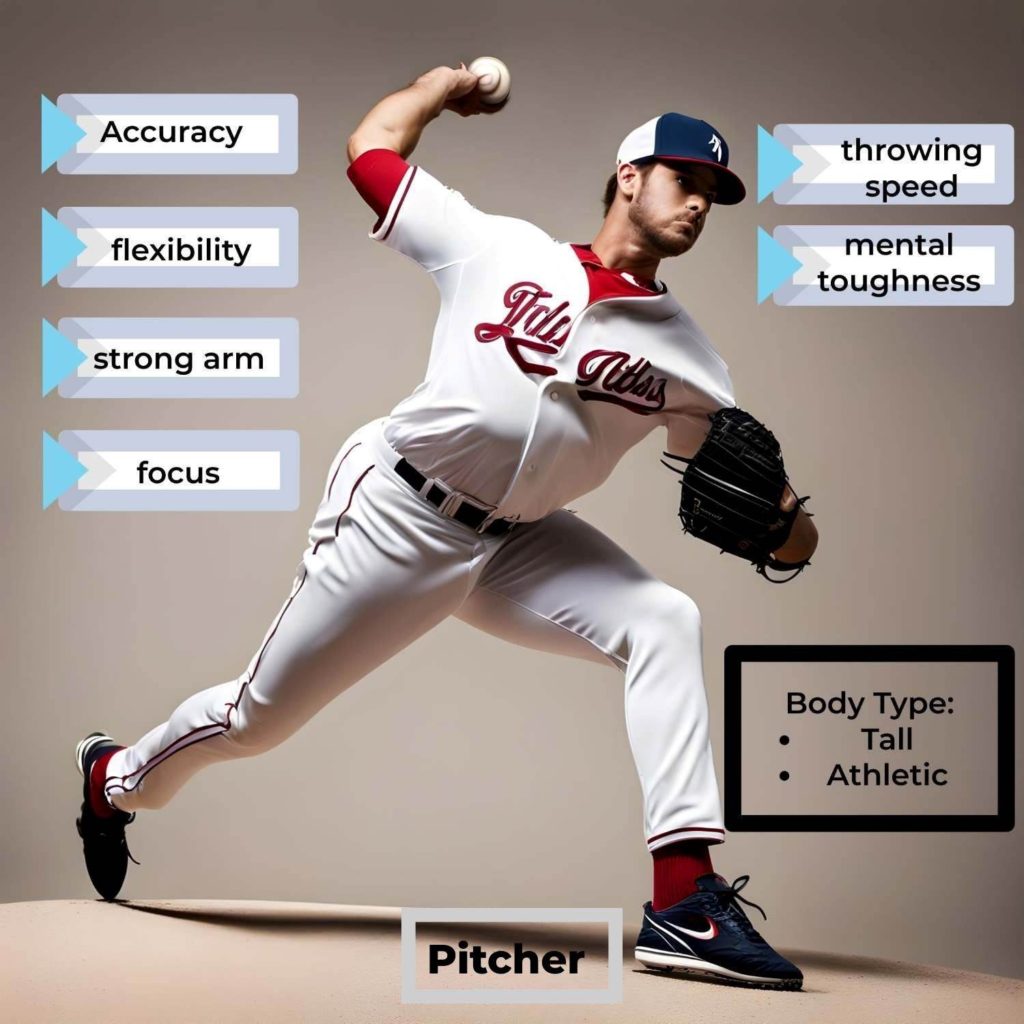
Catcher
Required Skills
- Consistent catching skills
- Leadership
- Intelligence
- Strong legs
- Quick feet
- Stamina
- Soft hands
- An exceptional throwing arm.
Body type
Players with medium height, flexible hips, and thick legs can endure the physical demands of this position.
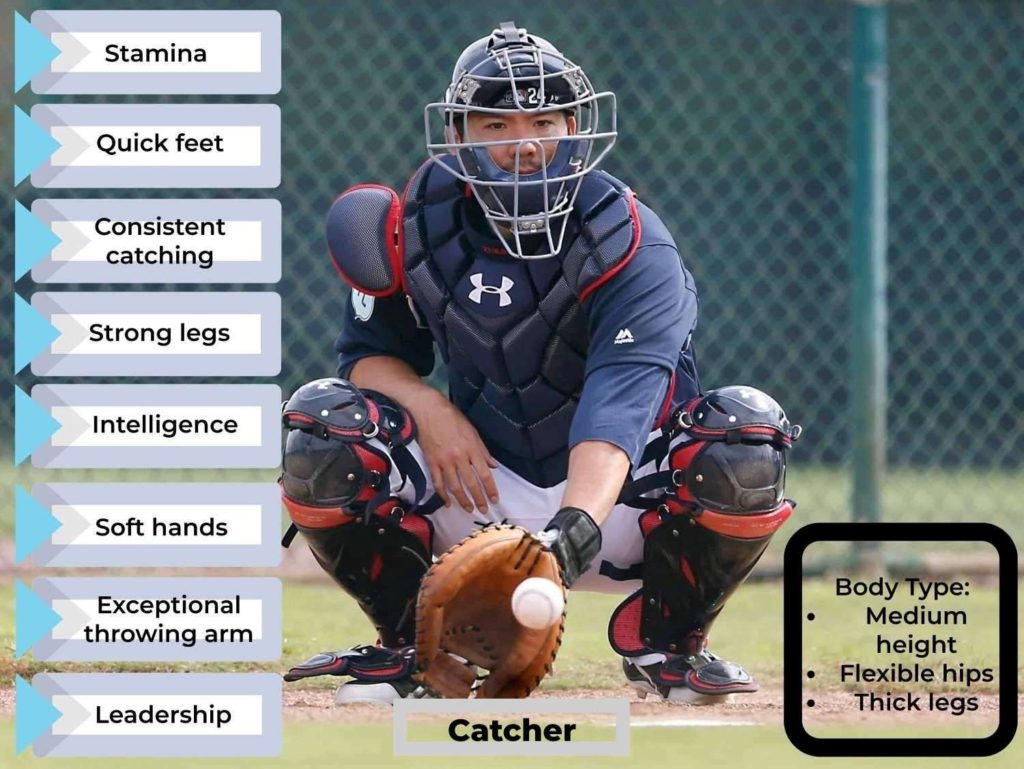
First Baseman
Required Skills
- Excellent catching
- Fielding ground balls
- Stretching to catch
- Keeping a foot on the base
- Hand-eye coordination
- Excellent vision.
Body type
Tall players with long arms can cover the base effectively and catch difficult throws.
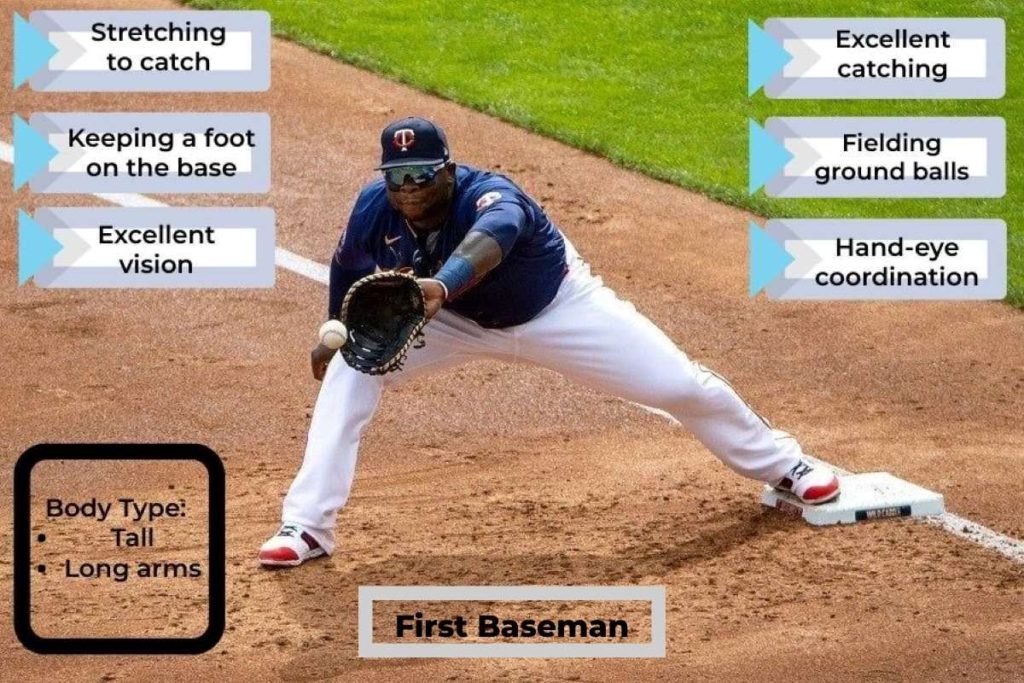
Second Baseman
Required Skills
- Lateral quickness
- Good hands
- Agility
- Ability to field ground balls.
Body Type
Short, athletic players can excel here due to the quick movements and agility required.
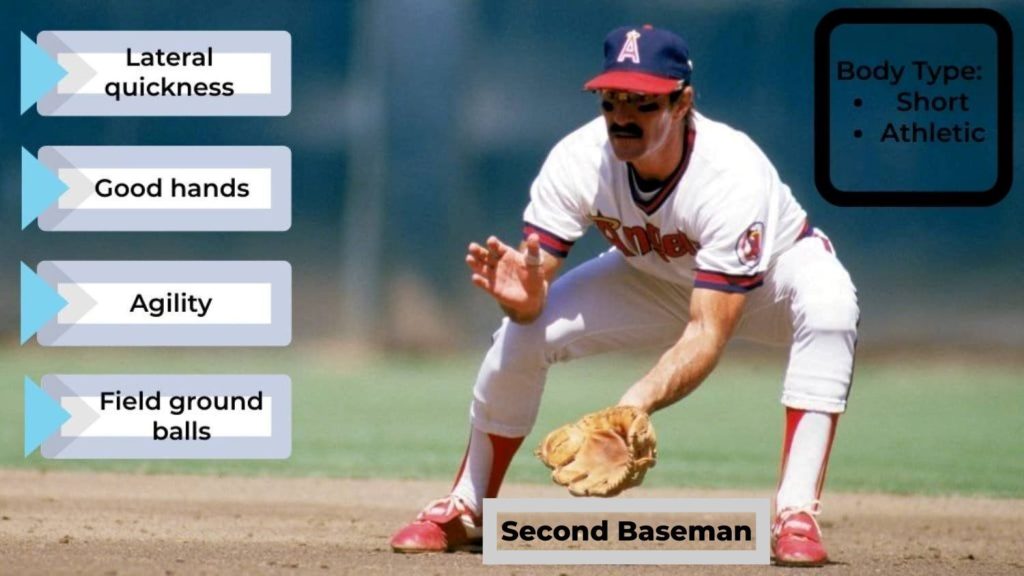
Third Baseman
Required Skills
- A good glove arm
- Quick reflexes
- Lateral quickness
- Confidence
- Balance.
Body Type
Medium-height players with quick reflexes are ideal for handling hard-hit balls.
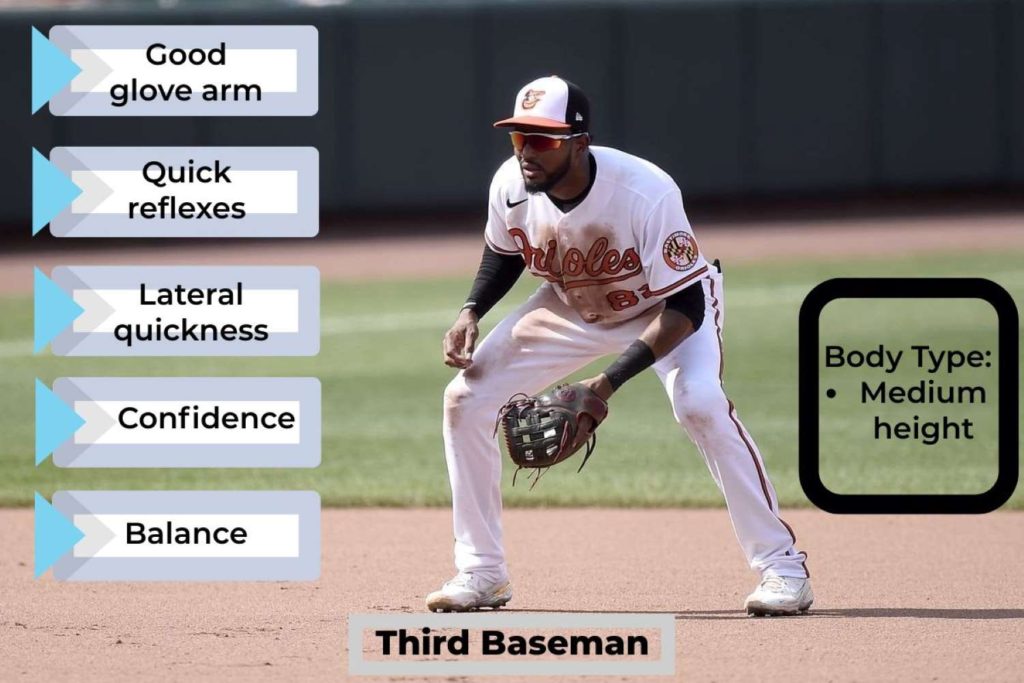
Shortstop
Required Skills
- Athleticism
- Strong arms
- Quick reflexes
- Soft hands
- Strong catching
- Throwing skills
- Field vision
- Game awareness.
Body Type
Medium-built players with athleticism and strong arms are well-suited for this demanding position.
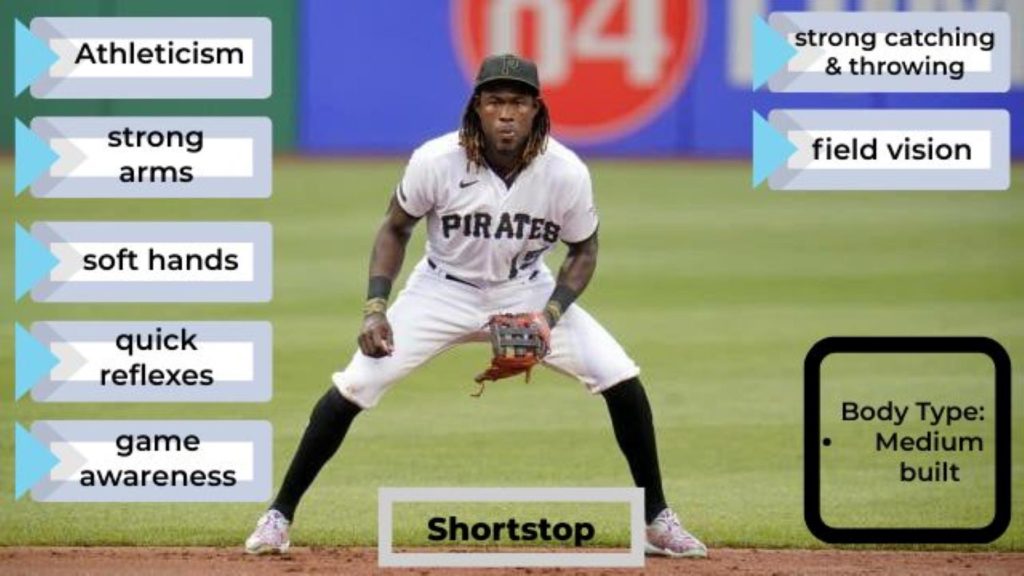
Outfielder (Left, Right, Centre)
Required Skills
- Ability to catch fly balls
- Hand-eye coordination
- Vision
- Speed
- Instincts
- Strong throwing arm
- Fielding skills with specific nuances for each position.
Body Type
A variety of body types can fit well in the outfield. Speed and arm strength are the key attributes.

Practice Drills For Specific Positions in Baseball
Each position on the baseball field requires a unique set of skills. To refine your skills, you need to practice drills tailored to your position. Let’s break it down:
Middle Infield (2nd Base and Shortstop)
If you are a middle infielder, your game is all about speed and precision. Your drills should mirror that. Work on your lateral movements; make them swift.
Practice turning double plays, focusing on quick catches and rapid releases. Agility drills that enhance side-to-side quickness can also be beneficial.
Corner Infield (1st Base and 3rd Base)
Corner infielders need a combination of soft hands and arm strength. If you are holding down the first base, get your hands ready to catch and field ground balls like a pro. And don’t forget those stretches to make the catches.
Third basemen often have to make long throws across the diamond. They should focus on drills that enhance reaction time and throwing accuracy.
Outfield (Left, Center, and Right)
Outfielders should consider drills that improve speed, arm strength, and anticipation. Practice tracking fly balls, focusing on reading the ball off the bat, and getting a quick jump.
Arm strength drills that enhance throwing power and accuracy can also help effectively throw runners out or hold them to a single base.
Catcher
Catchers are involved in every pitch, so drills should focus on enhancing arm strength, anticipation, and soft hands.
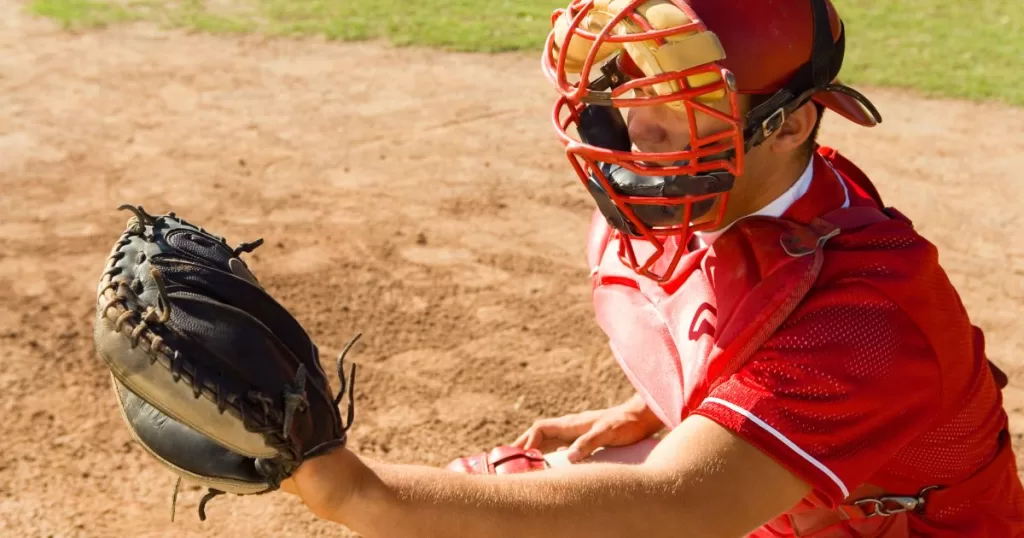
Practice blocking balls in the dirt, framing pitches, and throwing to bases to catch stealing runners. Mental drills that improve pitcher handling can also help.
Pitcher
Pitchers need a combination of arm strength, anticipation, and, often, height.
Drills should focus on improving throwing velocity, accuracy, and the development of off-speed pitches. You can improve your speed with a few drills.
How To Improve Mental Toughness?
In an intense game, staying focused and calm can make a huge difference. But how can you keep yourself cool when the pressure is on? Let’s find out:
Set Clear Goals
Define what you want to achieve in specific, measurable terms.
Instead of “I want to be a better hitter,” try “I aim to increase my batting average by 10 points this season.”
Develop a Routine
Create a consistent pre-game routine to build confidence and focus.
For example, you can follow a specific set of actions before every pitch or at-bat to center your mind and body.
Focus on What You Can Control
Concentrate on your actions and responses, not on external factors like umpire calls or crowd noise.
If a call doesn’t go your way, focus on the next pitch, not on arguing or feeling aggrieved.
Positive Self-Talk
Replace negative thoughts with positive affirmations to build confidence.
Let’s say: Instead of thinking, “I’ll probably miss,” tell yourself, “I’m prepared, and I have the skills to hit this ball.”
Visualize Success
Before a game, close your eyes and imagine yourself making great plays and hitting well.
Manage Anxiety
Learn relaxation techniques to calm nerves. For instance, you can take deep breaths before each play, focusing on exhaling slowly to release tension.
Embrace Pressure
In a tight game, remind yourself that these moments are chances to prove your abilities.
Learn from Failure
After an error or a loss, identify what you can learn and how you can improve, then let it go and focus on the next opportunity.
Seek Support
If you are struggling with confidence, talk to someone who can provide strategies and encouragement.
Celebrate Successes
Acknowledge and celebrate your achievements and improvements, no matter how small.
Made a great play or had a good at-bat? Give yourself credit and build on that positive energy.
Common Mistakes Made By Baseball Players In Choosing A Position
Picking the perfect spot in baseball can be tricky. And yeah, players slip up sometimes. But always remind yourself mistakes are not defeats but lessons, not the end but the beginning.
Let’s look at the common mistakes made by baseball players in choosing a position and how to dodge those pitfalls.
Ignoring Natural Skills and Abilities
Players sometimes look forward to positions that don’t align with their natural skills.
Assess your strengths and weaknesses honestly and choose a position where your natural talents can shine. Some players have great influence in the field and have great respect, but your natural skills may not be perfect for that position.
Overlooking Physical Attributes
Some do not consider physical attributes like height, speed, and arm strength when choosing a position.
Align your physical attributes with positions where they can be most beneficial. For instance, taller players often excel as pitchers.
Focusing Solely on Glory Positions
Many young players are drawn to positions like pitcher or shortstop without considering if they are the right fit for them.
Every position is valuable. Evaluate where you can contribute most to the team, not just where you’ll be in the spotlight.
Lack of Versatility
Specializing too early and not developing skills for multiple positions is another common mistake.
Be open to playing different positions. Versatility can make you a more valuable player and increase your understanding of the game.
Neglecting the Mental Aspect
Many focus only on physical skills and neglect the mental aspects of different positions.
Consider the mental demands of each position. For example, catchers need to think strategically and manage pitchers. Conversely, outfielders need focus and concentration.
Underestimating the Importance of Practice
Assuming natural talent alone is enough and neglecting continuous practice can also be a problem.
Dedicate time to sharpen your skills and improve your weaknesses.
Not Seeking Feedback
Some totally neglect taking feedback from coaches or experienced players when choosing a position.
Knowledgeable individuals can provide great insights into where your skills and attributes fit best in the field.
Ignoring Team Needs
Some choose a position based solely on personal preference without considering the team’s needs.
Always consider where you can contribute most to your team’s success. Sometimes, the team’s needs can offer opportunities to shine in unexpected positions.
Talk To Coaches And Experienced Players To Get Their Insight And Feedback.
Wisdom comes from experience, and who better to guide you than those who have walked the path?
Here’s why and how you should connect with coaches and seasoned players to enrich your game.
The Why
- Coaches and veteran players have a wealth of experience. They have seen players of all types and can provide insights that are tailored to your unique skills and attributes.
- It is easy to have a biased view of your abilities. These experts can offer an objective assessment. They will help you identify your strengths and areas for improvement.
- Coaches and experienced players can help you understand the mental and strategic aspects of different positions.
- These interactions will also help you grow as a player. You’ll gain insights that can help you develop your skills and approach to the game.
The How
- Don’t be shy. Reach out to coaches and experienced players, ask questions, and seek advice. Be open and receptive to their feedback.
- Go to workshops where you can interact with and learn from experts. It’s a hands-on way to gain insights and improve your skills.
- Observe how experienced players approach their positions. Watch their movements, techniques, and strategies. There is a lot to learn from simply being observant.
- When seeking advice, be specific about what you want to know. Ask about particular skills, strategies, or positions to get detailed and useful feedback.
- Don’t just gather information, but apply it. Take the feedback, work on your game, and continuously assess your progress.
In Practice:
Imagine you are a young player with great catching skills and a good arm, but you’re unsure where you fit on the field.
A conversation with a coach could provide clarity. They might observe your skills and suggest you try out as a catcher.
They might explain the role’s demands and how your attributes align with them.
Or perhaps you are a versatile player, able to fit into multiple positions. An experienced player could share their journey, how they improved their skills for different roles, and the mental adaptability required to switch between positions.
So, talking to coaches and experienced players can help you grow as a player. Their insights, borne from years of experience, can guide your journey. They can help you find your position and excel in it.
What Position Should You Choose?
Still confused; what position should you choose? Let’s get some more clarity with insights from an experienced coach.
Evaluate Your Strengths and Weaknesses
Start by taking a good look at what you are good at and where you might need some improvement.
Are you fast? Do you have a strong arm? How’s your catching ability?
Write down your strengths and weaknesses on paper. Be honest with yourself during this evaluation.
Consider Critical Skills
Rank your abilities in throwing speed, throwing distance, catching, running speed, and reaction time. These skills help in determining which position suits you best.
If you are fast and have a strong arm, positions like pitcher or outfielder might be a good fit. If your reaction time is excellent, consider playing in the infield.
Consider Your Body Type
Sometimes, your height and build influence the position you play. For instance, taller players often make excellent pitchers.
Conversely, those with quick reflexes and agility might be better suited for the infield.
Consider Your Mental Makeup:
Some positions, like pitcher and catcher, require a solid mental game. Assess your mental toughness, focus, and ability to handle pressure.
If you thrive under pressure and have a strategic mindset, these positions might be a good fit for you.
Experiment with Different Positions
High school is a great time to try out various positions. Don’t lock yourself into one spot too early.
Experiment. It will help you understand the game better and identify where you can be most effective.
Even if you are leaning towards a specific position, being versatile is something valuable.
Assess Team Needs and Dynamics:
Look at your team’s composition and needs. Where can you add the most value?
Sometimes, your team’s requirements can guide you to a position where you can make a greater impact.
Factor in Your Passion and Enjoyment
Beyond all the technical aspects, consider what you enjoy. Which position brings you the most joy and satisfaction?
Passion is a powerful driver of success. So, don’t overlook the positions you naturally gravitate towards.
Seek Continuous Feedback
Always keep the lines of communication open with your coach. Discuss the positions you are interested in.
Also, seek feedback on where your skills can be most beneficial for the team. Coaches appreciate players who are flexible and willing to adapt to the team’s needs.
Practice, Practice, Practice
Regardless of the position you are eyeing, keep practicing. Work on improving your skills.
Every baseball player, whatever their position, benefits from being a skilled hitter. So don’t neglect your batting practice.
Be Open to Change
Remember, the position you play can change over time. You might be a shortstop in high school and transition into a different role in college.
Being adaptable and open to learning new positions is a sign of a versatile player.
Frequently Asked Questions (FAQs)
Where do short players play in baseball?
Short players often play as second basemen. The position demands lateral quickness, good hands, and agility, but not necessarily height. Being short and athletic is actually an advantage here. It allows players to swiftly move and react to plays.
Why are pitchers tall?
Pitchers are often tall, as height can contribute to greater throwing velocity. A taller pitcher has a longer arm, which can create more whip and speed as they release the ball.
It is not a strict requirement, though. Mental toughness and accuracy are equally important for a pitcher.
Where is the easiest and hardest position to play in baseball?
The pitcher, shortstop, and catcher positions are the most demanding positions in baseball. They require a combination of physical skills and mental sharpness.
The easiest positions are often the first base and left field. They suit beginners or players still working on their skills.
Final Tips:
So, What Baseball Position Should You Play? Remember that every player brings something unique to the table.
Your combination of skills, physique, and mental sharpness is yours alone. And there is a spot on the field where those attributes will shine brightest.
If your arm is your strength, the pitcher’s mound might be for you. If you are a natural leader with quick reflexes and a sturdy build, the catcher’s position could be yours.
Are you fast, with a keen eye for fly balls? The outfield is always looking for speedsters like you.
Baseball is a mind game as much as it is physical. Flexibility, too, is invaluable. The best players are those who can adapt to a new position and make it their own. Be that player.
Be the one who’s ready to step up no matter where you are needed. Embrace every moment with confidence and passion. You’ve got this.
More Resources
What Are The Best Pitches To Throw In Baseball
What Is A Good Batting Average
What Is Rosin Bag And Why Is It Legal In Baseball
What Age Do Baseball Players Retire and Why?

Hello everyone. My name is Jason Butler, and I live in California, America. I was a professional AAA Minor League Baseball player. I lost my chance of playing MLB for injury issues, but I did not lose my love for baseball. I attended the coaching training program and am now working as a coach in a small school in San Diego.
I always love to share my experience and knowledge if that can help you. Play baseball, and stay fit.
